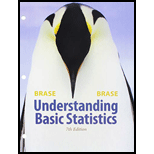
Concept explainers
Unifrom Distribution: Measurement Errors Measurement errors from instruments are often modeled using the uniform distribution (see Problem 12). To determine the
(a) less than +0.03 microsecond
(c) between -0.04 and +0.01 microsecond?
(d) Find the
(a)
To find: Theprobability thatsuch measurements will be in error byless than 0.03 microseconds.
Answer to Problem 13P
Solution: Theprobability that such measurements will be in error byless than 0.03 microsecondsis0.8.
Explanation of Solution
Calculation:
Let
Let x is chosen at random from [
We have to find the probability of less than 0.03 microseconds,
Hence,
(b)
To find: Theprobability thatsuch measurements will be in error bymore than -0.02 microseconds.
Answer to Problem 13P
Solution: Theprobability that such measurements will be in error by more than -0.02 microsecondsis0.7.
Explanation of Solution
Calculation:
Let
Let x is chosen at random from [
We have to find the probability of more than -0.02 microseconds,
Hence,
(c)
To find: Theprobability thatsuch measurements will be in error bybetween -0.04 and 0.01 microseconds.
Answer to Problem 13P
Solution: Theprobability that such measurements will be in error bybetween -0.04 and 0.01 microsecondsis0.5.
Explanation of Solution
Calculation:
Let
Let x is chosen at random from [
We have to find the probability between -0.04 and 0.01 microseconds,
Hence,
(d)
To find: Themean and standard deviation of measurement errors and whether the measurements for these acoustical sensors are unbiased.
Answer to Problem 13P
Solution:
The mean of measurement errors is 0. The standard deviation of measurement errors is 0.029. Yes, the measurements for these acoustical sensors are unbiased.
Explanation of Solution
Calculation:
Let
We have to find the mean,
Therefore, the mean is 0 microsecond.
We have to find the standard deviation,
Therefore, thestandard deviationis 0.029microsecond.
Yes, since the obtained mean of the measurement errors is zero so the measurements for these acoustical sensors are unbiased.
Want to see more full solutions like this?
Chapter 7 Solutions
Bundle: Understanding Basic Statistics, Loose-leaf Version, 7th + WebAssign Printed Access Card for Brase/Brase's Understanding Basic Statistics, ... for Peck's Statistics: Learning from Data
- Business Discussarrow_forwardThe following data represent total ventilation measured in liters of air per minute per square meter of body area for two independent (and randomly chosen) samples. Analyze these data using the appropriate non-parametric hypothesis testarrow_forwardeach column represents before & after measurements on the same individual. Analyze with the appropriate non-parametric hypothesis test for a paired design.arrow_forward
- Should you be confident in applying your regression equation to estimate the heart rate of a python at 35°C? Why or why not?arrow_forwardGiven your fitted regression line, what would be the residual for snake #5 (10 C)?arrow_forwardCalculate the 95% confidence interval around your estimate of r using Fisher’s z-transformation. In your final answer, make sure to back-transform to the original units.arrow_forward
 Mathematics For Machine TechnologyAdvanced MathISBN:9781337798310Author:Peterson, John.Publisher:Cengage Learning,
Mathematics For Machine TechnologyAdvanced MathISBN:9781337798310Author:Peterson, John.Publisher:Cengage Learning, Glencoe Algebra 1, Student Edition, 9780079039897...AlgebraISBN:9780079039897Author:CarterPublisher:McGraw Hill
Glencoe Algebra 1, Student Edition, 9780079039897...AlgebraISBN:9780079039897Author:CarterPublisher:McGraw Hill

